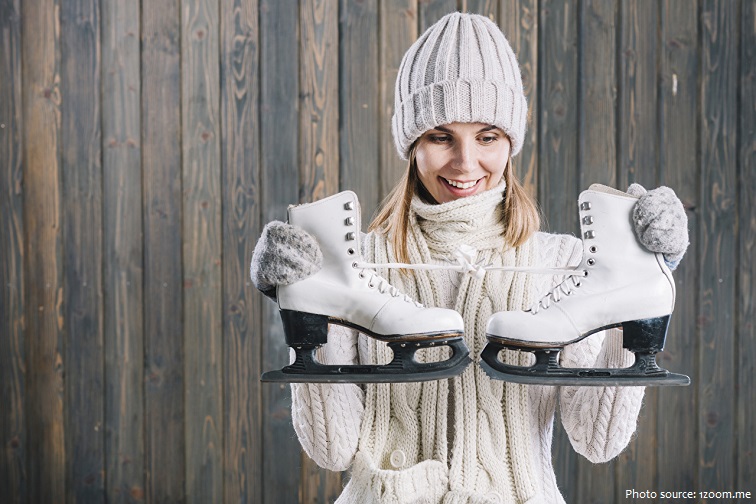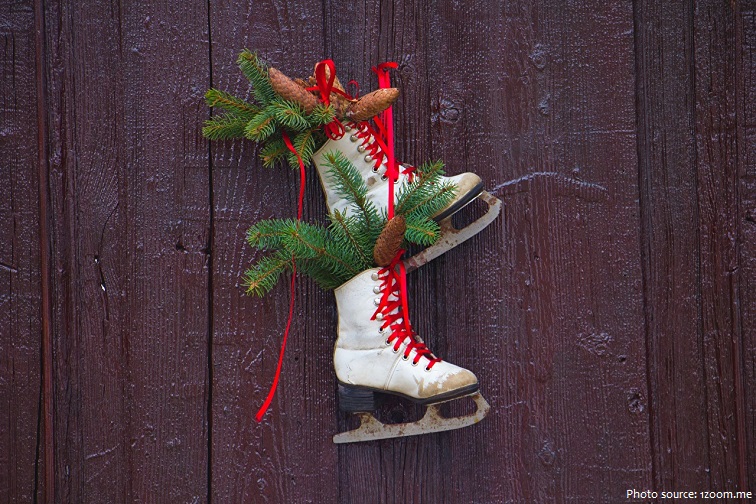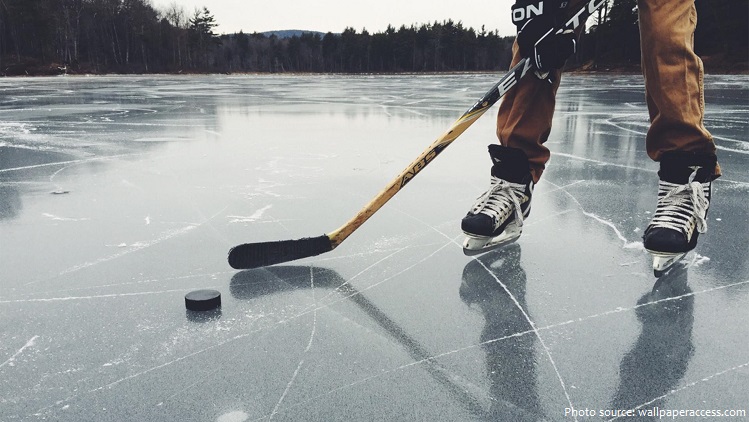
Ice skating is the recreation and sport of gliding across an ice surface on metal-bladed ice skates.
The activity of ice skating has given rise to two distinctive sports: figure skating, which involves the performance of various jumps, spins, and dance movements; and speed skating and short-track speed skating, both of which are forms of racing on ice skates. Ice hockey is the best-known team sport that involves skating.
According to a study done by Federico Formenti, University of Oxford, and Alberto Minetti, University of Milan, Finns were the first to develop ice skates some 5,000 years ago from animal bones. This was important for the Finnish populations to save energy in harsh winter conditions when hunting in Finnish Lakeland. It was also important for the Finnish people to invent ice skates as Finland has about 187,888 lakes. In the olden days the villages used to get separated by lakes, to go between lakes the Finnish people had two options first to go around the lake and second to find a way through the slippery surface of the lakes. The earliest known skate to use a metal blade was found in Fennoscandia and was dated to 200 A.D., and was fitted with a thin strip of copper folded and attached to the underside of a leather shoe.

Research suggests that the earliest ice skating happened in southern Finland more than 4,000 years ago. This was done to save energy during winter journeys.
Ice skating was also practiced in China during the Song dynasty, and became popular among the ruling family of the Qing dynasty.
True skating emerged when a steel blade with sharpened edges was used. Skates now cut into the ice instead of gliding on top of it. The Dutch added edges to ice skates in the 13th or 14th century. These ice skates were made of steel, with sharpened edges on the bottom to aid movement.
In England “the London boys” had improvised butcher’s bones as skates since the 12th century. Skating on metal skates seems to have arrived in England at the same time as the garden canal, with the English Restoration in 1660, after the king and court returned from an exile largely spent in the Netherlands.

The first organised skating club was the Edinburgh Skating Club, formed in the 1740s – some claim the club was established as early as 1642.
On the Continent, participation in ice skating was limited to members of the upper classes. Emperor Rudolf II of the Holy Roman Empire enjoyed ice skating so much, he had a large ice carnival constructed inhis court in order to popularise the sport. King Louis XVI of France brought ice skating to Paris during his reign. Madame de Pompadour, Napoleon I, Napoleon III, and the House of Stuart were, among others, royal and upper-class fans of ice skating.
In 1848, a man named E. V. Bushnell from Philadelphia invents a strapless skate with the blades clipped right to the boot. This revolutionizes ice skating because for the first time skaters can twist, turn, spin and leap without losing their ice skate blades!

The first artificial ice rink (mechanically-refrigerated) was built in 1876, at Chelsea, London, England and was named the Glaciarium. It was built near the King’s Road in London by John Gamgee.
The first artificially frozen rink in the United States was installed in the old Madison Square Garden in New York City in 1879. Throughout the century more and more public rinks with artificially produced ice appeared. The ability to create sheets of ice inside large arenas gave rise to both skating sports and ice shows, which became a popular family entertainment in the 20th century. It also allowed for ice skating to spread to regions with warm climates.
In 1914, John E. Strauss, a blade maker from St. Paul, Minnesota, invented the first closed-toe blade made from one piece of steel, making skates lighter and stronger. And, in 1949, Frank Zamboni trademarked the ice resurfacing machine that bears his name.

The largest, man-made outdoor ice rink is the Fujikyu Highland Promenade Rink in Japan, built in 1967. It boasts an ice area of 165,750 square feet, the equivalent of 3.8 acres. It is still in use today.
The largest ice skating pinwheel was achieved by 84 participants from Trafford Youth Synchronised Ice Skating Teams (UK) at Altrincham Ice Rink in Altrincham, Cheshire, UK, on 21 July 2012.
The largest ice skating lesson involved 523 participants and was achieved by Ilya Urazakov (Kazakhstan) at the Medeo ice skating rink, Almaty, Kazakhstan, on 18 January 2014.
The longest ice skating trail measures 29.98 km (18.63 miles) and it is the naturally frozen Lake Windermere Whiteway, in Invermere, British Columbia, Canada, as measured on 14 February 2014.

The record for the greatest distance skated in 24 hours belongs to Martinus Kuiper (Netherlands) who skated 546.65km (339.67 miles) at Alkmaar, Netherlands on 12-13 December 1988.
Dutch speed skater Kjeld Nuis tore up the record books by reaching 103kph over natural ice on Norway’s Savalen Lake. The 32-year-old Olympic champion exceeded the 100kph mark as he added a further 10kph to his existing speed record.
The men’s record for barrel jumping is 18 barrels, by Yvon Jolin Junior (Canada) at Terrebonne, Quebec, Canada on 12 April 1980. The distance jumped was 8.43 m (27 ft 8 in).Each barrel measured 40.6 cm (16 in) in diameter and 76.2 cm (30 in) long.
The fastest spin on ice skates is 342 RPM and was achieved by Olivia Oliver (Canada) in Warsaw, Poland, on 19 January 2015.
The most continuous upright spins on ice skates on one foot is 115 by Lucinda Ruh (Switzerland) at Chelsea Piers Sky Rink, New York, USA on 3 April 2003.